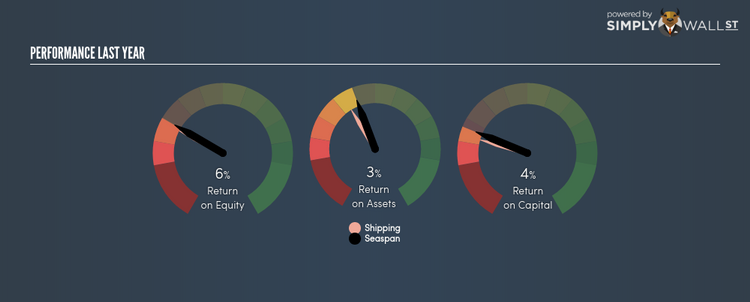Can Seaspan Corporation (NYSE:SSW) Continue To Outperform Its Industry?

Seaspan Corporation (NYSE:SSW) delivered an ROE of 6.45% over the past 12 months, which is an impressive feat relative to its industry average of 5.93% during the same period. While the impressive ratio tells us that SSW has made significant profits from little equity capital, ROE doesn’t tell us if SSW has borrowed debt to make this happen. In this article, we’ll closely examine some factors like financial leverage to evaluate the sustainability of SSW’s ROE. View our latest analysis for Seaspan
Breaking down Return on Equity
Firstly, Return on Equity, or ROE, is simply the percentage of last years’ earning against the book value of shareholders’ equity. It essentially shows how much the company can generate in earnings given the amount of equity it has raised. In most cases, a higher ROE is preferred; however, there are many other factors we must consider prior to making any investment decisions.
Return on Equity = Net Profit ÷ Shareholders Equity
Returns are usually compared to costs to measure the efficiency of capital. Seaspan’s cost of equity is 16.11%. This means Seaspan’s returns actually do not cover its own cost of equity, with a discrepancy of -9.66%. This isn’t sustainable as it implies, very simply, that the company pays more for its capital than what it generates in return. ROE can be broken down into three different ratios: net profit margin, asset turnover, and financial leverage. This is called the Dupont Formula:
Dupont Formula
ROE = profit margin × asset turnover × financial leverage
ROE = (annual net profit ÷ sales) × (sales ÷ assets) × (assets ÷ shareholders’ equity)
ROE = annual net profit ÷ shareholders’ equity
Basically, profit margin measures how much of revenue trickles down into earnings which illustrates how efficient the business is with its cost management. Asset turnover reveals how much revenue can be generated from Seaspan’s asset base. And finally, financial leverage is simply how much of assets are funded by equity, which exhibits how sustainable the company’s capital structure is. Since ROE can be inflated by excessive debt, we need to examine Seaspan’s debt-to-equity level. At 169.69%, Seaspan’s debt-to-equity ratio appears relatively high and indicates the above-average ROE is generated by significant leverage levels.
What this means for you:
Are you a shareholder? SSW’s ROE is impressive relative to the industry average, though its returns were not strong enough to cover its own cost of equity. Additionally, its high debt level appears to be the driver of a strong ROE and is something you should be mindful of before adding more of SSW to your portfolio. If you’re looking for new ideas for high-returning stocks, you should take a look at our free platform to see the list of stocks with Return on Equity over 20%.
Are you a potential investor? If you are considering investing in SSW, basing your decision on ROE alone is certainly not sufficient. I recommend you do additional fundamental analysis by looking through our most recent infographic report on Seaspan to help you make a more informed investment decision.
To help readers see pass the short term volatility of the financial market, we aim to bring you a long-term focused research analysis purely driven by fundamental data. Note that our analysis does not factor in the latest price sensitive company announcements.
The author is an independent contributor and at the time of publication had no position in the stocks mentioned.


